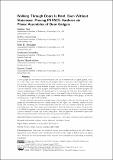| dc.contributor.author | Ani, Joshua | |
| dc.contributor.author | Bosboom, Jeffrey William | |
| dc.contributor.author | Demaine, Erik D | |
| dc.contributor.author | Diomidov, Y | |
| dc.contributor.author | Hendrickson, Dylan H. | |
| dc.contributor.author | Lynch, Jayson | |
| dc.date.accessioned | 2020-12-15T21:37:46Z | |
| dc.date.available | 2020-12-15T21:37:46Z | |
| dc.date.issued | 2020 | |
| dc.identifier.uri | https://hdl.handle.net/1721.1/128836 | |
| dc.description.abstract | A door gadget has two states and three tunnels that can be traversed by an agent (player, robot, etc.): the “open” and “close” tunnel sets the gadget's state to open and closed, respectively, while the “traverse” tunnel can be traversed if and only if the door is in the open state. We prove that it is PSPACE-complete to decide whether an agent can move from one location to another through a planar assembly of such door gadgets, removing the traditional need for crossover gadgets and thereby simplifying past PSPACE-hardness proofs of Lemmings and Nintendo games Super Mario Bros., Legend of Zelda, and Donkey Kong Country. Our result holds in all but one of the possible local planar embedding of the open, close, and traverse tunnels within a door gadget; in the one remaining case, we prove NP-hardness. We also introduce and analyze a simpler type of door gadget, called the self-closing door. This gadget has two states and only two tunnels, similar to the “open” and “traverse” tunnels of doors, except that traversing the traverse tunnel also closes the door. In a variant called the symmetric self-closing door, the “open” tunnel can be traversed if and only if the door is closed. We prove that it is PSPACE-complete to decide whether an agent can move from one location to another through a planar assembly of either type of self-closing door. Then we apply this framework to prove new PSPACE-hardness results for several 3D Mario games and Sokobond. | en_US |
| dc.language.iso | en | |
| dc.publisher | Dagstuhl Publishing | en_US |
| dc.relation.isversionof | http://dx.doi.org/10.4230/LIPIcs.FUN.2021.3 | en_US |
| dc.rights | Creative Commons Attribution 3.0 unported license | en_US |
| dc.rights.uri | https://creativecommons.org/licenses/by/3.0/ | en_US |
| dc.source | DROPS | en_US |
| dc.title | Walking through doors is hard, even without staircases: Proving PSPACE-hardness via planar assemblies of door gadgets | en_US |
| dc.type | Article | en_US |
| dc.identifier.citation | Ani, Joshua et al. "Walking through doors is hard, even without staircases: Proving PSPACE-hardness via planar assemblies of door gadgets." Leibniz International Proceedings in Informatics 157: 3 © Joshua Ani et al. | en_US |
| dc.contributor.department | Massachusetts Institute of Technology. Department of Electrical Engineering and Computer Science | en_US |
| dc.relation.journal | Leibniz International Proceedings in Informatics | en_US |
| dc.eprint.version | Final published version | en_US |
| dc.type.uri | http://purl.org/eprint/type/ConferencePaper | en_US |
| eprint.status | http://purl.org/eprint/status/NonPeerReviewed | en_US |
| dc.date.updated | 2020-12-09T18:26:54Z | |
| dspace.orderedauthors | Ani, J; Bosboom, J; Demaine, ED; Diomidov, Y; Hendrickson, D; Lynch, J | en_US |
| dspace.date.submission | 2020-12-09T18:26:57Z | |
| mit.journal.volume | 157 | en_US |
| mit.license | PUBLISHER_CC | |
| mit.metadata.status | Complete | |

